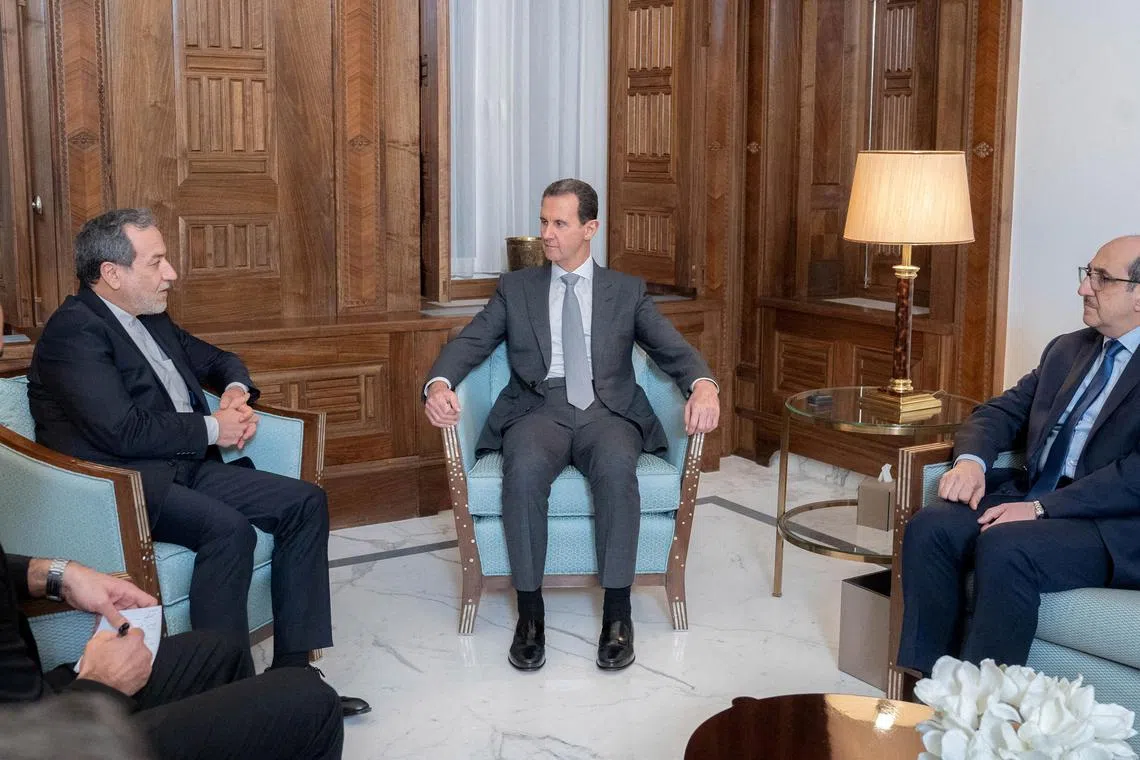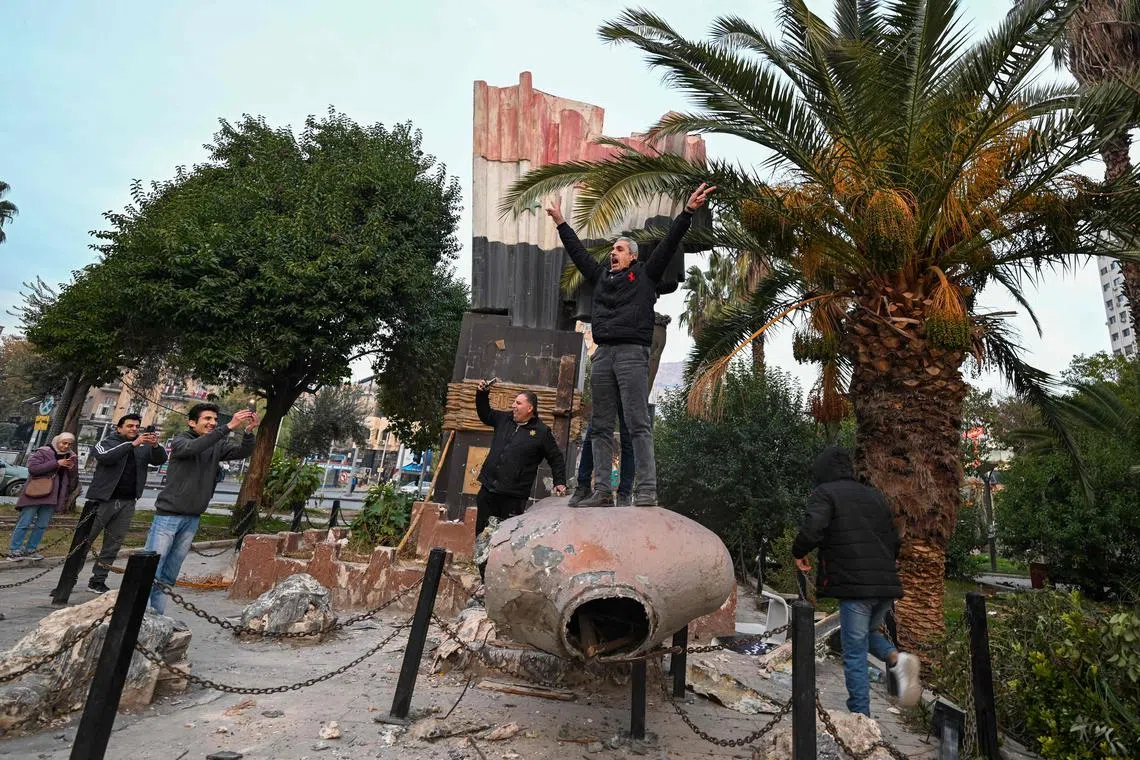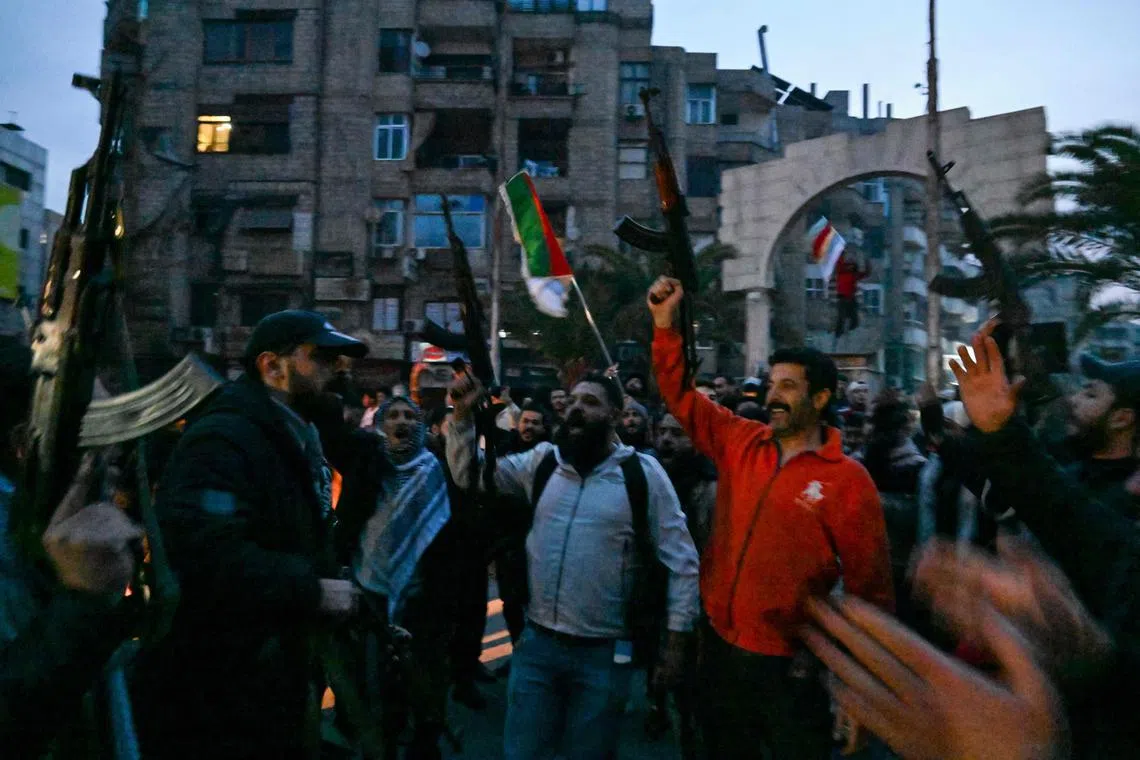News analysis
In the Syrian regime’s hour of need, its patron Iran hits the exits
Sign up now: Get ST's newsletters delivered to your inbox

Syrian President Bashar al-Assad (centre) meeting Iranian Foreign Minister Abbas Araghchi (left) in Damascus on Dec 1.
PHOTO: REUTERS
Follow topic:
For decades, Iran has expended much blood and money in support of Syrian President Bashar al-Assad, helping him survive a civil war that threatened his dynastic rule. Iran operated military bases, weapons warehouses and missile factories in Syria, which it used as a pipeline for arming its militant allies across the region.
Last week, just as Mr Assad needed help to repel a rapid advance by rebel forces, Iran headed for the exits. On Dec 6, the country started evacuating its military commanders and personnel, as well as some diplomatic staff, according to Iranian and regional officials.
It is a remarkable turnabout: Iran not only appears to have abandoned Mr Assad, its closest Arab ally, but also relinquished everything it had built and fought to preserve for 40 years in Syria, its main foothold in the Arab world.
With rebels arriving in the Syrian capital of Damascus
A collapse of Iran’s partnership with Syria would by all accounts reshape the balance of power in the Middle East. The “Axis of Resistance” that Iran has formed with its militant allies in Lebanon, the Palestinian territories, Syria, Iraq and Yemen would be weakened. Israel and its Arab allies would be strengthened.
“For Iran, Syria has been the backbone of our regional presence,” Mr Hassan Shemshadi, an expert on Iran’s proxy militant groups who was for years a documentary filmmaker on the battlefields of Syria, said in an interview from the Iranian capital of Tehran. “Everything that Iran sent to the region went through Syria. It is now extremely difficult to keep these channels open.”
Shock at speed of rebels’ advance
Initially, the Iranian government was shocked at how quickly the rebels in Syria gained ground and the Syrian army abandoned its bases, according to three Iranian officials, two of them members of the elite Revolutionary Guard, and two prominent Iranian analysts close to the government.
By midweek, the mood had turned into full panic, the officials said, as the rebels were on a march that would hand them city after city, from Aleppo to Hama to Deir el-Zour and Daraa.
Publicly, Iranian officials vowed to remain fully committed to supporting Mr Assad. But privately, as the rebels gained control over more and more territory where Iran and its proxy militias had reigned, they wondered if events were outpacing their ability to turn the tide, the officials said.

Local residents cheering as they gather on a street in the Damascus suburb of Jaramana on Dec 8, even as Syrian rebels called on citizens abroad to return to a “free Syria”.
PHOTO: AFP
By the end of the week, several senior officials had made statements on social media that Mr Assad’s ouster was seemingly inevitable and Iran’s setback monumental.
“The potential fall of the Syrian government to Islamist extremists would be one of the most significant events in the history of the Middle East,” Mr Mohammad Ali Abtahi, a former vice-president of Iran, wrote on social media platform X. “Resistance in the region would be left without support. Israel would become the dominant force.”
Although Iranian Foreign Minister Abbas Araghchi, who has travelled to Damascus, Baghdad and Doha, Qatar, for consultations on Syria, at first struck a defiant tone, he later said Mr Assad’s fate would be left to “God’s will”.
An internal memo from a Revolutionary Guard member that was viewed by The New York Times described the situation in Syria as “unbelievable and strange”. It is as if “Iran accepted the fall of Assad and has lost the will to resist”, the memo says.

People standing on top of a toppled statue of Syria’s late president Hafez al-Assad in Damascus on Dec 8.
PHOTO: AFP
State television in Shi’ite-majority Iran switched from calling the Sunni rebels “infidel terrorists” to “armed groups” and reported that they had so far treated Shi’ite minorities well.
Mr Soheil Karimi, a former fighter in Syria turned political pundit, said on a state television news programme that Mr Araghchi’s pledges of support to Syria’s government were nothing but false hope.
“The reality in the field is not what he says,” Mr Karimi said, citing reports from his contacts in Syria. “Our guys are not in the battlefield in Syria now. They have not been allowed.”
A video posted on Dec 6 on social media accounts affiliated with the Revolutionary Guard showed a Shi’ite shrine near Damascus almost empty. A narrator says: “These may be the last images you see of the shrine. Everyone has left Syria. All the Iranians have evacuated.”
He then breaks into sobs.
The shrine, Sayyidah Zaynab, is the tomb of the granddaughter of the Prophet Muhammad and has played a central role in Iran’s war narrative in Syria. Iranian soldiers who fought in Syria are commonly referred to as “defenders of the shrine”.
Iran in a bind
The three Iranian officials said that Hayat Tahrir al-Sham, the main rebel group advancing in Syria, sent Iran a private diplomatic message this past week. The group promised that it would protect Shi’ite religious sites and Shi’ite minorities and asked Iran not to fight its forces, according to the officials. Iran, in turn, asked the group to allow safe passage of its troops out of Syria and to protect Shi’ite shrines, according to two officials.
Iran deployed commanders and troops to Syria in 2012 at the start of the anti-government uprising, helping to defeat opponents of the Assad regime and the ISIS militant group.
It used its continued foothold in Syria to maintain a robust weapons supply chain to Hezbollah in Lebanon and to Palestinians in the West Bank, including through two shipping ports and airports. More recently, Iran partnered smuggler gangs and some members of Bedouin tribes in Jordan to send arms from Syria to the West Bank.
But the dynamics of the Middle East have changed vastly in the past year.
Iran suffered significant blows as Israel attacked Iranian assets and bases in Syria, including its embassy compound in Damascus. Israel killed at least two dozen Iranian soldiers, some of them senior commanders in charge of regional operations, according to Iranian media.
In addition, Iran’s key ally, Hezbollah, was battered after an intense period of fighting with Israel in Lebanon. Russia, another ally of Syria, is focused on its own war with Ukraine. More crucially, Syria’s army has demonstrated an unwillingness to fight.

Local residents cheering as they gather on a street in the Damascus suburb of Jaramana on Dec 8. Syrian rebels said that President Bashar al-Assad has fled the country.
PHOTO: AFP
Yet another concern for Iran was Israel’s threat to attack any mobilisation of Iranian troops in Syria, according to analysts inside and outside the country. Two flights by a private Iranian airline en route to Damascus were turned around this past week after warnings by Israel that it would shoot them down if they entered Syria’s airspace, according to Iranian and Israeli officials. Israel said the flights were transferring weapons.
For Iran to enter this fight, it would require “massive logistical and financial resources”, as well as help from allies and Syria itself, said Mr Mehdi Rahmati, a Syria analyst in Tehran who has advised the government. “None of these conditions exist right now.”
Dr Afshon Ostovar, an associate professor of national security affairs at the Naval Postgraduate School in California and an expert on Iran’s military, said Iran was in a bind, particularly with President-elect Donald Trump returning to the White House and expected to enforce a policy of “maximum pressure on Iran”.
“Losing ground in Syria will make Iran look increasingly weak to its enemies in Tel Aviv and Washington,” Dr Ostovar said. “If Iran doubles down on Syria, it could be throwing men and materiel into a losing battle. But if Iran falls back, it will appear weak, be admitting defeat, and cede hard-fought territory to its enemies.” NYTIMES

